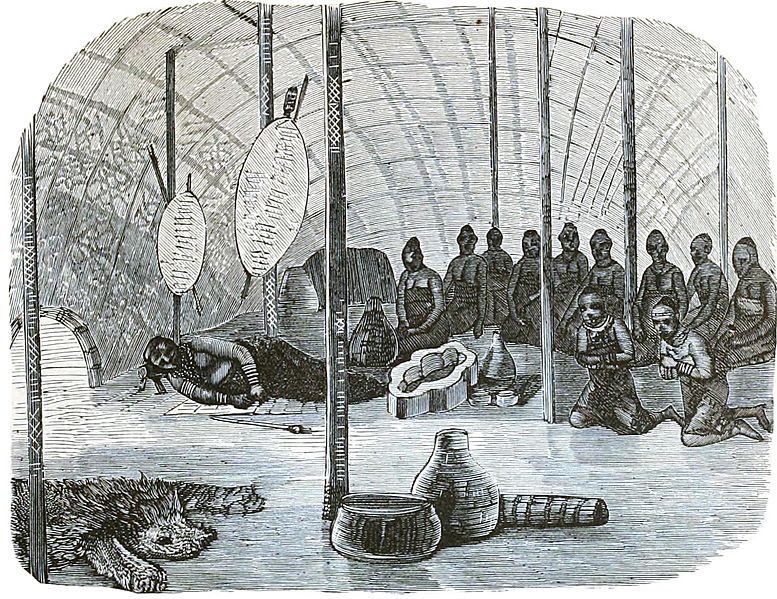Image: Dingan at home

Description: (1.) DINGAN AT HOME (see page 207.)The illustration, "Dingan at home," on page 209, represents the mode in which a Kaffir reposes. The individual who is reclining is the great Kaffir monarch, Dingan, and the reader will observe that his bed is a mere mat, and that his pillow is only a block of wood. The hut which is here represented is the celebrated one which he built at his garrison town Ukunginglove, and it was specially noted because it was supported by twenty pillars. The fireplace of this hut was remarkable for its shape, which, instead of being he simple circle in general use among the Kaffirs, resembled in form that ornament which is known to architects by the name of quatrefoil. A few of his wives are seen seated round the apartment, and, as Dingan was so great a man, they were not permitted to stand upright, or even to use the feet in any way, so that, of the wished to move from one part of the hut to another, they were obliged to shuffle about on their knees. The illustration is taken from a sketch by Captain Gardiner, who was invited by Dingan to an interview in the house, and during which interview he rather astonished his guest by retiring for a short time, and then presenting himself with his face, limbs, and body entirely covered with red and white spots, like those on toy horses. The reader can form, from the contemplation of this drawing, a tolerably accurate idea of the luxuries afforded by the wild, savage life which some authors are so fond of praising.Identifier: uncivilizedraces00wood (find matches)Title: The uncivilized races of men in all countries of the world : being a comprehensive account of their manners and customs, and of their physical, social, mental, moral and religious characteristicsYear: 1878 (1870s)Authors: Wood, J. G. (John George), 1827-1889Subjects: Ethnology Manners and customs SavagesPublisher: Hartford : J. B. Burr and companyContributing Library: University of California LibrariesDigitizing Sponsor: Internet ArchiveView Book Page: Book ViewerAbout This Book: Catalog EntryView All Images: All Images From Book Click here to view book online to see this illustration in context in a browseable online version of this book.Text Appearing Before Image:me. In this point they aid themselves by the violent gestures in which they indulge. A Kaffir differs from an European vocalist in this point, namely, that he always, if possible, sits down when he sings. He and his companions will squat in a circle, sometimes three or four rows deep, and will shout some well-known song at the top of their voices, sway- of course, the quality of a Kaffir's voice is not that which would please an European vocalist. Like all uncultivated songsters, the Kaffir delights in strong contrasts, now using a high falsetto, and now dropping suddenly into a gruff bass. It is a very remarkable fact that this method of managing the voice is tolerably universal throughout the world, and that the accomplished vocalist of Kaffirland, of China, of Japan, of Persia, and of Arabia, sings with exactly that falsetto voice, that nasal twang, and that abrupt transition from the highest to the lowest notes, which characterize our uneducated singers in rural districts. Put a WiltshireText Appearing After Image:(a.) WOMEN QUARRELLING. (See page 213.)(209) MUSICAL INSTRUMENTS. 211 laborer and a Chinese gentleman into different rooms, shut the doors so as to exclude the pronunciation of the words, ask them to sing one of their ordinary songs, and the hearer will scarcely be able to decide which room holds the English and which the Chinese vocalist. In the specimens of music which have been given, the reader will notice in several places the sudden rise or drop of a whole octave, and also the curiously jerking effect of many passages, both eminently characteristic of music as performed in country villages where modern art has not modified the voice. The musical instruments of the Kaffir are very few, and those of the most simple kind. One is the whistle that is often diverted from its normal duty as a mere whistle, to become a musical instrument, which, although it has no range of notes, can at all events make itself heard through any amount of vocal accompaniment. And, as a Kaffir thinks that a song is noNote About Images Please note that these images are extracted from scanned page images that may have been digitally enhanced for readability - coloration and appearance of these illustrations may not perfectly resemble the original work.
Usage Terms: Public domain
Image usage
The following 2 pages link to this image:

